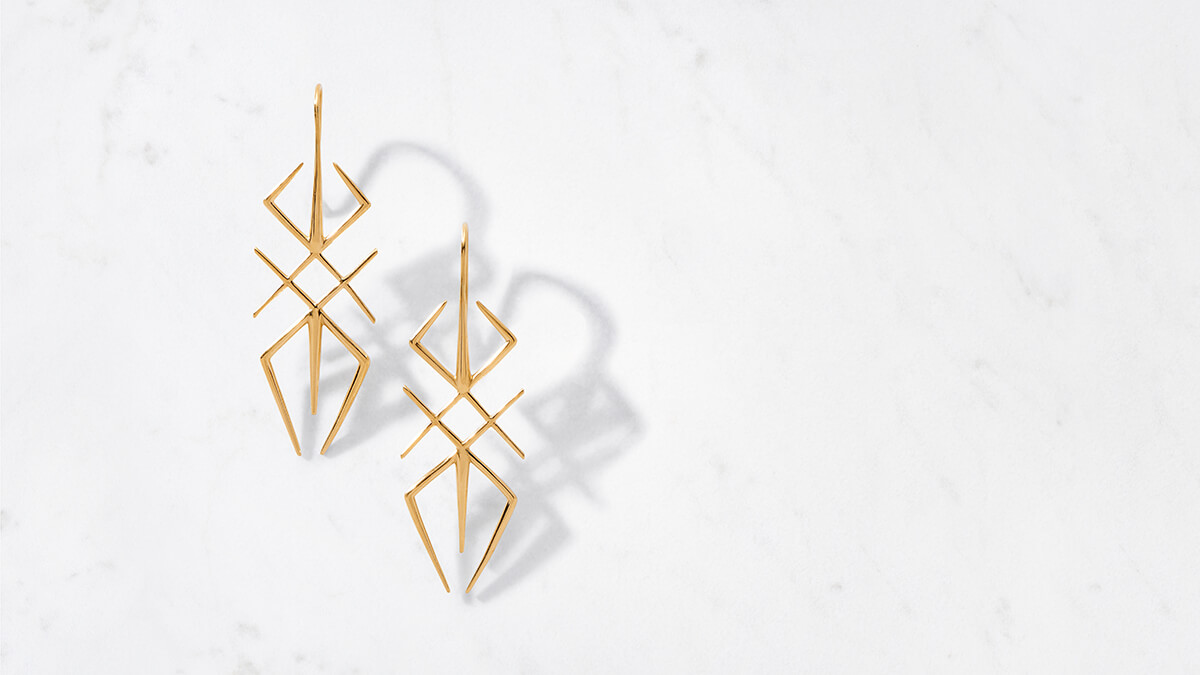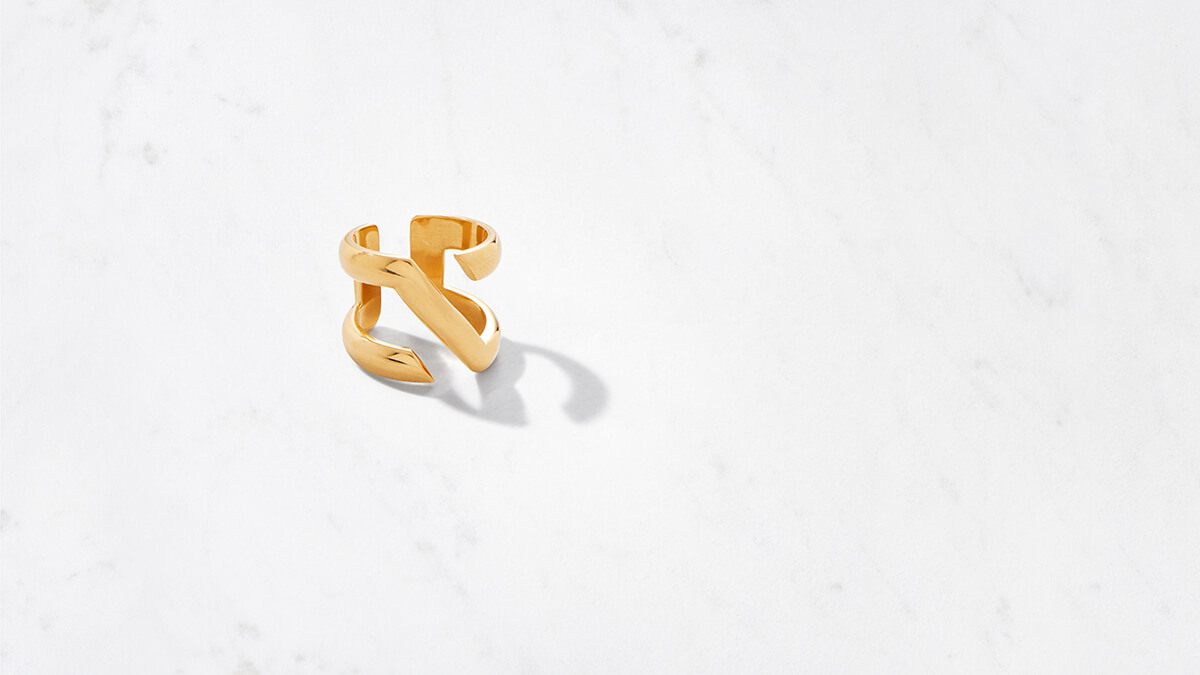You don’t have to be an expert to appreciate the beauty and timeless appeal of gold jewelry, but it certainly doesn’t hurt if you’re well-versed in its lingo. The more you know, the more confident you will be in your decision making when it comes to what and how you buy. So, don’t worry if you don’t speak gold yet, we’ll have you fluent in no time. It’s as easy as A-Z.
ALLOY: An alloy is a mix of two or more metals. 14 karat gold is an alloy of 58.3% gold and another metal; 18 karat gold is an alloy of 75% gold and another metal; 22 karat gold is an alloy of 92% gold and another metal; and 24 karat gold is unalloyed pure gold.
ASSAY: An assay is a purity test of gold and other alloys.
AU: The chemical symbol for gold, which is derived from ‘Aurum,’ the Latin word for ‘shining dawn.’
BARK FINISH: Gold that has been treated with a bark finish will have thick lines and valleys embedded in its surface, so that it literally looks like tree bark.
BLACK GOLD: A special effect using high heat on a solid color core will create a different color surface such as black gold.

Auvere Arthropod Earring Polished
BRUSHED: Brushed gold has been scratched on the surface with a wire brush, creating tiny lines. Typically the lines are parallel, but the artisan may choose a more random design.
CASTING: This ancient form of creating jewelry dates back to Egypt’s 18th Dynasty in 1549 BCE. Also known as the ‘lost wax method,’ where a wax mold is created, heated and injected with molten metal. While the cast is still hot, it’s immersed in cold water that ultimately shatters the cast, but leaves the gold object in tact. This remains the most common form of gold fabrication.
CHASING: This technique creates a design relief on the front side of the gold that adds dimension and actually sinks the metal to a low indentation by stretching the metal through heat.
ELECTROFORMING: An old technique that forms gold objects by electrically depositing metal over a mold. This method is good for thin, hollow jewelry, and is now frequently used for costume jewelry.
EMBOSSING: A stamping process that creates a raised or sunken design.
ENGRAVING: The process of cutting a design into the surface of gold by hand or machine.
ETCHING: An etched effect is created by pouring acid onto unprotected parts of gold. The acid dissolves the exposed surface to create an intended design.
FILIGREE: A delicate, open-work piece of gold wires that are turned or soldered together. Filigree creates a lace-like, romantic look.

Auvere Golden Globe Necklace
FINENESS: Fineness is a measure of gold’s purity. Typically a 3-digit number compared with 1000. A 999 gold is 99.9% pure and will be as high as it gets.
FINE WEIGHT: The metallic weight of a piece of jewelry as opposed to the gross weight of the item, which contains the weight of the alloying metal.
GOLD PLATING: Gold plated jewelry has a fine coating of gold layered onto the surface.
GRAIN WEIGHT: A gold weight measurement used for very small quantities.
GRAM WEIGHT: The metric weight measurement. A gram of gold is equal to approximately 1/32 of a troy ounce (31.1035 grams = 1 troy ounce).
GRANULATION: The fusion of tiny gold spheres added to a surface without soldering.
GREEN GOLD: A naturally occurring alloy of gold and silver that gives off a greenish hue.
HALLMARK: A guarantee mark of gold’s purity and origin, incised or stamped directly on the gold. The fineness, assaying office and fabricator may also be included.

Auvere Slash Ring Polished
HANDCRAFTED: The art of making jewelry solely by hand.
INTERMETTALICS: An alloy or compound that is comprised of two or more metals resulting in unique, atypical colors like purple, blue, amethyst or violet.
KARAT: The basic measure of gold purity. Each karat denotes 1/24 of 100% purity, thus 24 karats which is usually expressed as 24k, is pure gold. 22k is 92% pure gold mixed with 8% of another metal – usually sterling silver.
MATTE: A dull, soft finish that diffuses light rather than reflecting it. A matte finish is achieved by sandblasting with fine grains of sand or with a rotating wire brush that creates a warm, satiny finish.
NOBLE METAL: A metal that resists chemical action, does not erode and is easily affected by acids. Such metals include gold, platinum, silver, palladium, rhodium and iridium.
NUGGET JEWELRY: The soldering of gold nuggets to a gold surface.

Auvere Tall Maze Cuff
POLISHED: A high shine, super smooth finish that reflects light like a mirror.
PURE GOLD or SOLID GOLD: In the U.S., pure (or solid) gold refers to 24k, or .999 fine gold. Pure gold is never mixed with another metal.
ROSE GOLD: A copper alloy with small amounts of silver or zinc resulting in the warm rosy, pink shade.
SATIN FINISH: A soft, lightly textured finish on the surface created by very fine brushing.
SCRAP GOLD: Any gold, including jewelry that is meant to be melted down and sold for its bullion content.
STAMPING: Stamped gold is pressed between two metal blocks carved with a particular design.
TRADEMARK: A tiny mark that denotes a brand, importer or retailer may be added to a piece of jewelry. Trademarks, and hallmarks, are usually placed inside rings, on the underside of pieces, on bracelet clasps and on earring posts, where they remain inconspicuous.
TROY WEIGHT: The measure of gold ounces. One troy pound = 12 troy ounces. Troy ounces are 10% heavier than avoirdupois pounds, which = 16 ounces. Avoirdupois is used for almost every other weight measurement in the U.S. Always make sure when you buy and sell gold, that you are using the troy weight.
WHITE GOLD: An alloy of gold mixed with a white metal like nickel, manganese or palladium.


















